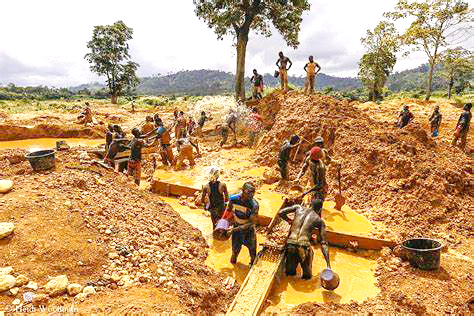By Oddoye Naa Djama Wilhelmina (Email:wilhelminaoddoye53@gmail.com | UniMAC-IJ, Faculty of Journalism)
For the past decades, gold mining and agriculture have continuously boosted Ghana’s economy. As at 2013, the primary cash crop, cocoa, produced an estimated US$1,731 million in exports, while gold mining contributed US$3,673 million. (Ghana Government, 2013). Although farming is still the primary source of income in most communities with access to natural resources, artisanal and small-scale mining (ASM) has become a profitable industry due to its exceptional ability to generate cash.
Mining and agriculture may co-exist and interact to generate economic and social benefits, but at the same time they compete for land, water resources and labour. On the one hand, land that could otherwise be utilized for farming is taken over for mining; labour is diverted away from agriculture to mine; and mining pollutes water used for farm irrigation.
Ghana is one of Africa’s leading gold producers and the eleventh top producer globally in 2023 and large commercial companies mine the majority of gold in Ghana, using heavy machinery. Despite this, small-scale gold mining accounts for around 35 percent of the nation’s gold production; many of these mines are informal and/or operate without a permit. Locals refer to this unlicensed, artisanal, small-scale gold mining as “galamsey,” which is derived from the phrase “gather them and sell.” In Ghana, galamsey is a significant source of income for a large number of individuals. It provides support for over 4.5 million additional people and employs about one million people.
However, the surge in unregulated mining has had a number of negative implications, including significant damage to local ecosystems. As of 2018, galamsey had caused approximately 29,000 hectares of deforestation, with 1,000 hectares occurring within the country’s protected areas.
The mineral sector is critical in resource-rich countries, particularly those in development. Mining in Ghana accounted for around 41% of overall export revenues and 12% of government revenue in 2020. However, large-scale mining can have a severe impact on other industries, including agriculture. Mining in Ghana is often carried out in rural locations where the population are poor and rely on natural resources and agriculture for sustenance. These regions are also significant agricultural producing centres for the country.
The expansion of the mining industry has created issues, notably for host towns. The rise of large-scale mining operations has led to homelessness and the displacement of communities.
Some displaced community members, including farmers, are employed by mining firms, either permanently or on contract, because most mining corporations normally have a policy of employing a percentage of their work force from the impacted local communities.
However, majority of farmers prefer in the longer term ‘crops’ to ‘carats’ because farming is more sustainable compared to ASM. And also because farming is the economic activity they have long lived with.
Ghana produced an amount of cocoa weighing in at over one million tonnes of in 2011, breaking previous records. Illegal mining has however led to a decline in cocoa production, resulting in a loss of 740,000 tonnes in 2015. This has had a detrimental influence on the income of West African farmers.
In conclusion, Ghana faces a critical challenge in balancing the economic benefits of gold mining with the long-term sustainability of its agricultural sector. While galamsey offers quick income for some, it comes at a devastating cost to Ghana’s ecosystems and agricultural potential. The decline in cocoa production serves as a stark reminder of the long-term damage unregulated mining can inflict.
To ensure a prosperous future, the Ghanaian government must take decisive action with a multi-pronged approach including stricter regulations and enforcement, high investment in agriculture and promote sustainable mining practices. Ghana’s rich natural resources can be a source of prosperity, but only if managed responsibly. By prioritizing environmental sustainability and supporting agriculture, the government can pave the way for a brighter future where both sectors can thrive in harmony.






































